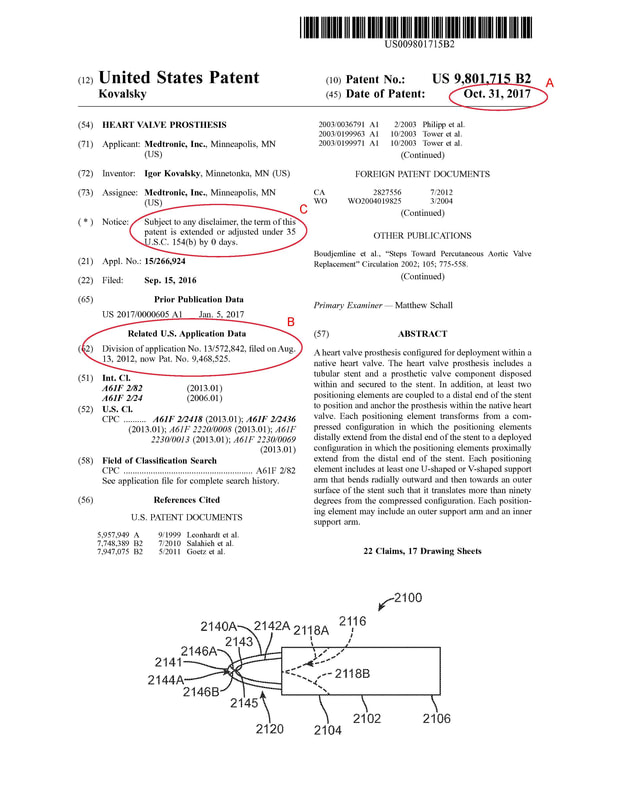|
A patent is issued in the name of the United States under the seal of the United States Patent and Trademark Office (USPTO). A patent confers “the right to exclude others from making, using, offering for sale, or selling the invention throughout the United States or importing the invention into the United States” and its territories and possessions for a period of time. So, how long does a patent last? On the date a patent issues, the “right to exclude” comes into force. So, how long can a patent owner exclude others from the above activities, or in patent parlance, what is the “patent term?” To determine the “life” of a patent, you must start with the earliest filing date of the patent application in the United States. Generally speaking, a patent term is 20 years from that date. In order to keep that patent in force, the patent owner must pay maintenance fees at three specific time periods during the patent term. Four important aspects of a patent term thus include: (1) what is the issue date of the patent, (2) when was the application first filed in the US, (3) has the USPTO adjusted the patent term, and (4) when are maintenance fees due? It is best to consult a patent attorney or agent to determine the actual expiration date of a patent, but you can begin to calculate the expiration date by looking at the front page of the patent of interest. For example, in the patent below, you can see (A) the issue date of the patent (the date from which the patent is in force), (B) the earliest date the application was filed in the United States, and (C) the patent term adjustment: In this Example, the patent rights are in force on October 31, 2017 (A). It was first filed in the United States on August 13, 2012 (B), and it did not receive any patent term adjustment (C). Now to the calculation: 20 years from (B) is August 13, 2032 + zero (0) days of patent term adjustment = an expiration date of August 13, 2032. The patent owner can enforce the patent for the period of October 31, 2017 to August 13, 2032, so long as they pay maintenance fees. Although it is best to verify items (B) and (C) through the USPTO Patent Application Information Retrieval (PAIR) system, this can give you a starting place for determining the patent term. You can access Public PAIR here: https://portal.uspto.gov/pair/PublicPair Maintaining the Patent Once the patent is issued, it must be maintained by paying maintenance fees to the USPTO. The USPTO established three 6-month time periods during the patent term when maintenance fees are due: (1) at 3 to 3.5 years; (2) at 7 to 7.5 years; and (3) at 11 to 11.5 years. These dates are measured from the Date of Patent, (A) in the example above. If a maintenance fee is not paid by the due date, there is a grace period of 6 additional months after the deadline, during which the fee can be paid (with a surcharge). Information about paying maintenance fees can be found at: https://www.uspto.gov/patents-maintaining-patent/maintain-your-patent. To see specific maintenance fee deadlines and whether a patent owner has paid them, select “View maintenance fee information” from this webpage. After a patent expires, either by running through its 20-year term, or because the patent owner failed to pay a maintenance fee, the public is free to use the invention claimed in that patent. Note, however, that this right is subject to any other patents that may exist in the particular field. Patent terms are as individual as the technology they describe. Although this article provides some guidelines for understanding how long a patent can be enforced, additional technical considerations such as terminal disclaimers, have not been covered. It is best to consult with a patent attorney or agent to determine the specific patent term and implications of a specific patent. Questions? Feel free to contact me.
2 Comments
11/15/2022 12:30:18 pm
Thank you for explaining that a patent lasts twenty years generally. I've been curious about this since my son mentioned he has something he wants to patent. It's good to know that it will last a decent amount of time if it goes through.
Reply
Karrie Weaver
11/15/2022 04:03:32 pm
Olivia, I am happy to hear you found this information useful. Best wishes to your son. Karrie
Reply
Your comment will be posted after it is approved.
Leave a Reply. |
AuthorKarrie Weaver practices intellectual property, trademark, patent, and trade secret law. Archives
February 2021
Categories |
612.386.0565
Copyright 2021. Weaver Legal and Consulting LLC. | All rights reserved.
Website by RyTech, LLC
Copyright 2021. Weaver Legal and Consulting LLC. | All rights reserved.
Website by RyTech, LLC


 RSS Feed
RSS Feed